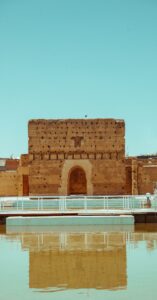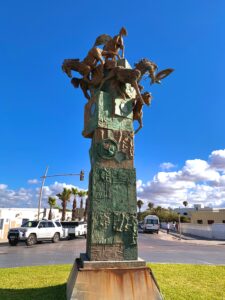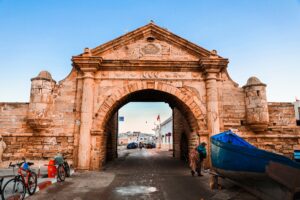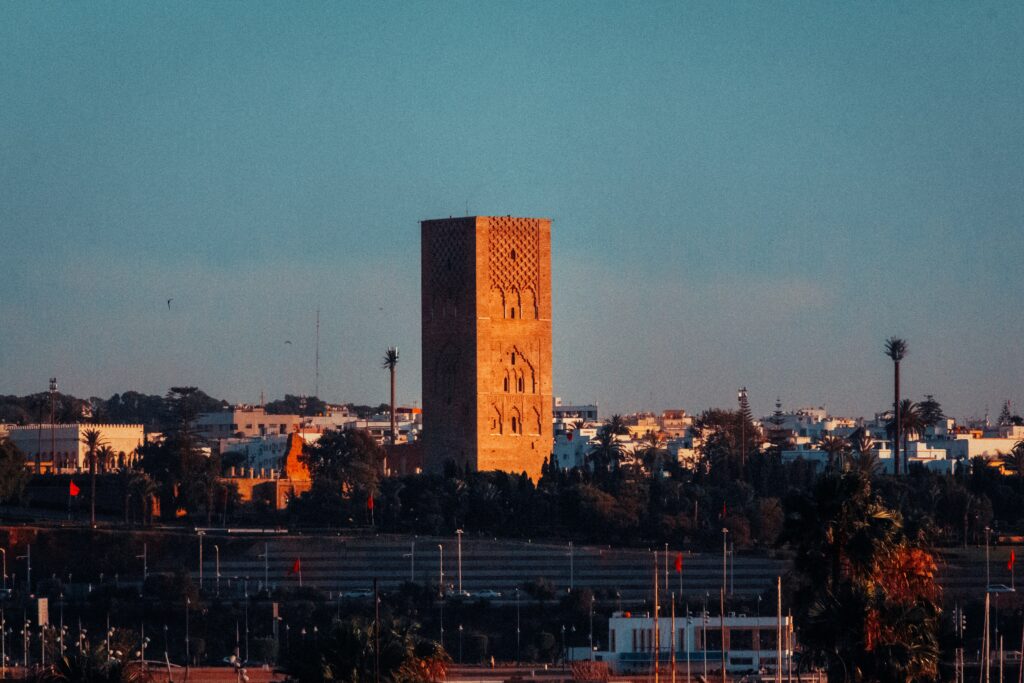
Nestled along the shores of the Atlantic Ocean, Rabat, the capital city of Morocco, is a captivating blend of history, culture, and modernity. Its recognition as a UNESCO World Heritage Site in 2012 underlines its significance as a city that harmoniously balances its rich past with the demands of the present.
Historical Tapestry: Architectural Marvels
Rabat, the capital city of Morocco, is a living testament to the rich historical tapestry that has woven itself through the centuries. At the heart of this narrative lie the architectural marvels that stand as guardians of the city’s past, each structure telling a unique story of cultural evolution and endurance.
The Kasbah of the Udayas: A Fortress of Time
Perched on a hill overlooking the mighty Atlantic Ocean, the Kasbah of the Udayas is a medieval fortress that transports visitors to a bygone era. Its stone walls, weathered by centuries of coastal winds, house a labyrinth of narrow streets, white-washed houses, and intricately designed doorways. The Kasbah is not merely a structure; it is a living embodiment of Rabat’s early history, a testament to the strategic importance of this coastal city.
Wandering through the Kasbah’s alleys, one can almost hear the echoes of the past—the stories of Berber dynasties, Andalusian refugees, and the various rulers who left their mark on these ancient stones. The Kasbah is not frozen in time; it is a continuum, a place where history breathes through every cobblestone.
Hassan Tower: A Testament to Unfinished Majesty in the Heart of Rabat
Standing tall against the Moroccan sky, Hassan Tower is not merely a structure; it is a poetic declaration of grandeur and an unfinished symphony echoing through the centuries. Rising above the cityscape of Rabat, this iconic tower serves as a poignant reminder of both the historical ambitions and the enduring legacy of Morocco.
Architectural Ambitions Unveiled
Commissioned by Sultan Yacoub al-Mansour in the 12th century, Hassan Tower was intended to be the minaret of what was envisioned to be the largest mosque in the world. The sheer scale of the project reflected the aspirations of the Almohad dynasty to create a religious and architectural masterpiece that would rival any on the global stage.
The initial design boasted a minaret reaching a height of 80 meters, an ambitious undertaking that aimed not only to symbolize the grandeur of Almohad rule but also to serve as a beacon of Islamic faith. However, history had different plans for Hassan Tower, and the minaret construction came to an abrupt halt in 1199 following the death of Sultan Yacoub al-Mansour.
The Unfinished Symphony
What remains today is a testament to the grand ambitions of a bygone era and the relentless march of time. The incomplete tower, standing at approximately half its intended height, is a hauntingly beautiful relic that captures the imagination of those who encounter its majestic ruins.
The tower’s intricate designs, characterized by decorative motifs and geometric patterns, hint at the grandeur that was meant to be. The red sandstone columns, some still standing and others lying scattered across the site, tell a story of both architectural prowess and the challenges faced during construction.
Historical Significance and Spiritual Legacy
Despite its incomplete state, Hassan Tower remains an integral part of Rabat’s historical and spiritual landscape. The site encompasses not only the tower but also the remnants of the mosque and the mausoleum housing the tombs of King Mohammed V and his sons.
The historical significance of the site extends beyond its original purpose. Over the centuries, Hassan Tower has become a symbol of Morocco’s enduring cultural and religious identity. It serves as a poignant reminder of the impermanence of human endeavors and the ways in which history shapes the narratives we inherit.
Preservation Challenges and UNESCO Recognition
Hassan Tower, like many historical monuments, faces the challenges of weathering, erosion, and the passage of time. The delicate process of preservation and restoration is ongoing, with dedicated efforts to ensure that future generations can continue to marvel at its unfinished majesty.
In 2012, UNESCO recognized the cultural and historical importance of Rabat, including the Hassan Tower, by designating the city as a World Heritage Site. This recognition not only honors the city’s commitment to preserving its architectural heritage but also places Rabat on the global stage as a custodian of humanity’s shared history.
Contemplating Unfinished Beauty
In the heart of Rabat, Morocco, amid the echoes of centuries past, stands Hassan Tower—an architectural marvel frozen in time, an unfinished symphony that invites contemplation on the nature of beauty, ambition, and the relentless march of history.
Silent Echoes of Aspirations
As one approaches the grounds surrounding Hassan Tower, the air is thick with a profound sense of aspiration frozen in stone. The intended magnificence of this towering structure, envisioned by Sultan Yacoub al-Mansour in the 12th century, remains eternally suspended in the Moroccan sky. The silent echoes of the initial ambition to construct the world’s largest mosque speak of a bygone era, a testament to the grand aspirations of the Almohad dynasty.
Walking amidst the remnants of red sandstone columns and the intricate geometric patterns that adorn the base of the tower, one cannot help but feel a connection to the dreams that were halted abruptly. It is a place where the whispers of history blend with the breeze, inviting visitors to contemplate the significance of unfinished beauty.
The Incomplete Symphony of Red Sandstone
Hassan Tower’s unique charm lies in its incomplete state. Rising to a height of approximately half its intended stature, the tower stands as an incomplete symphony, a canvas where the brushstrokes of ambition were abruptly halted. The red sandstone columns, some upright and others lying in graceful disarray, tell a story not only of construction but also of interruption—a narrative of grandeur interrupted by the inevitable twists of history.
The intricacies of the geometric carvings and decorative motifs on the existing columns are a testament to the craftsmanship of the era, preserving the memory of artisans who dedicated their skills to creating a masterpiece that remains a beacon of architectural inspiration.
Spiritual Legacy and Symbolism
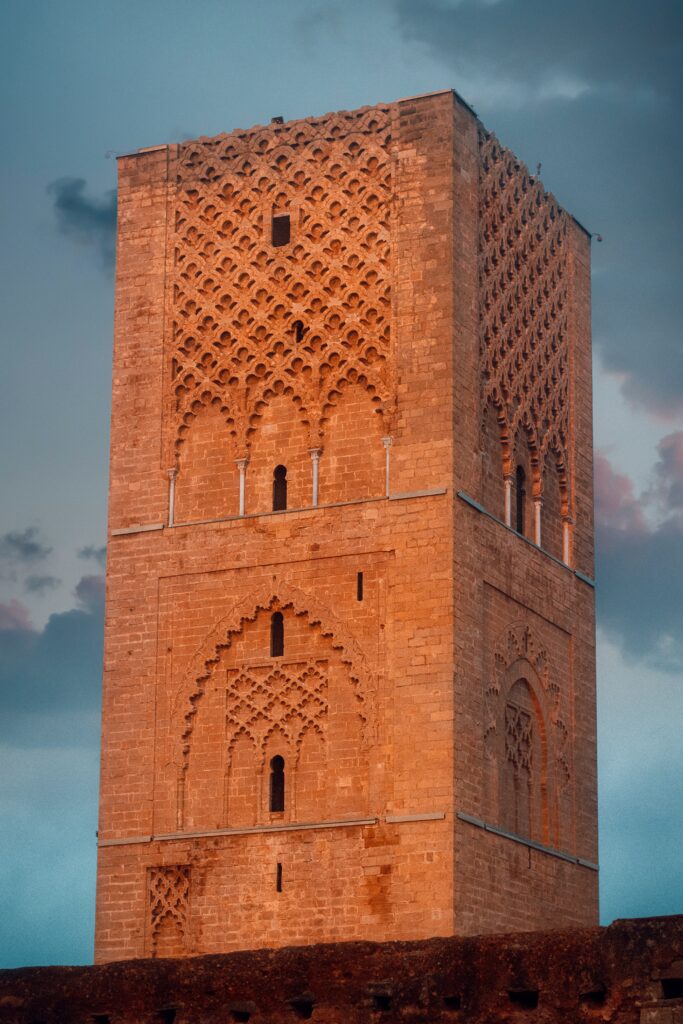
Beyond its architectural significance, Hassan Tower is an integral part of Rabat’s spiritual legacy. Adjacent to the unfinished minaret lies the mausoleum, where the tombs of King Mohammed V and his sons find their eternal resting place. The juxtaposition of the incomplete tower with the spiritual sanctuary of the mausoleum creates a symbolic harmony—a reminder that even in incompleteness, there can be a sense of spiritual fulfillment and continuity.
Visitors, whether they come seeking historical insights or spiritual reflection, are met with a landscape that transcends the temporal boundaries of human construction. The tower becomes a canvas upon which the complexities of existence are painted—a place where the unfinished becomes a metaphor for the ongoing journey of history and human endeavor.
Preservation Challenges and Reverence
Preserving Hassan Tower presents a delicate challenge. The red sandstone, exposed to the elements for centuries, requires meticulous conservation efforts to safeguard its unique beauty. Efforts to maintain the site’s integrity while allowing it to bear witness to the passage of time underscore Rabat’s commitment to honoring its historical narrative.
The reverence with which locals and visitors alike approach Hassan Tower speaks to its enduring impact. It is a place where time stands still, and contemplation becomes a natural response to the juxtaposition of the intended and the incomplete.
UNESCO Recognition and Global Reverence
In 2012, Hassan Tower, along with Rabat’s historic sites, received the prestigious UNESCO World Heritage status. This international acknowledgment not only places the site on a global pedestal but also emphasizes the universal significance of preserving cultural heritage, even in its unfinished state.
As Hassan Tower continues to inspire contemplation, it stands as a global reminder that beauty can be found in the incomplete. It urges us to reflect on the impermanence of human endeavors and the perpetual cycle of creation and interruption that defines our shared history.
A Timeless Invitation
Hassan Tower, with its unfinished majesty, extends a timeless invitation. It calls upon each visitor to pause, contemplate, and become part of the ongoing narrative etched in its stones. In its incompleteness, it finds a unique and enduring beauty—a beauty that transcends the limitations of time and invites all who gaze upon it to ponder the complexities of ambition, interruption, and the eternal echoes of history.
Mausoleum of Mohammed V: Modern Islamic Elegance
Nestled within the heart of Rabat, the Mausoleum of Mohammed V is a masterpiece of modern Islamic architecture. Built to honor the father of modern Morocco, King Mohammed V, the mausoleum exudes an air of elegant simplicity. The green tiled roof and the white silhouette of the building stand in contrast to the blue sky, creating a visual harmony that mirrors the balance between tradition and progress in Rabat.
The mausoleum is not merely a final resting place; it is a symbol of the nation’s unity and continuity. The precision of its design, the meticulous details of the interior, and the serene atmosphere within its walls all contribute to the mausoleum’s role as a contemporary architectural gem that seamlessly integrates with Rabat’s historic landscape.
Preservation and UNESCO Recognition
The architectural marvels of Rabat are not frozen in time; they are dynamic entities that require careful preservation. Recognizing the exceptional value of these structures, UNESCO bestowed World Heritage status upon Rabat in 2012. This recognition is not only an acknowledgment of the city’s historical significance but also a call to action to protect and transmit this cultural legacy to future generations.
Rabat’s architectural tapestry, woven with the threads of ancient fortresses, unfinished towers, and modern mausoleums, is a story of resilience, adaptation, and continuity. As the city embraces its UNESCO recognition, it does so with a commitment to ensuring that these architectural marvels remain integral to the city’s identity—a testament to the enduring spirit of Rabat through the ages.
Architectural Diversity: Bridging the Past and Present
In the heart of Rabat, Morocco, the cityscape is a harmonious blend of architectural styles that seamlessly weave together the threads of the past and the demands of the present. This architectural diversity stands as a testament to Rabat’s unique identity, where the old and the new coexist, creating a city that bridges historical richness with modern innovation.
The Ancient Medina: A Living Tapestry

The historic medina of Rabat, with its narrow winding streets and bustling souks, is a living tapestry that transports visitors to a bygone era. Here, the architecture echoes the traditions of Moroccan design, characterized by intricate tilework, geometric patterns, and elaborately carved wooden doors. The medina is a labyrinth where history is etched into every stone, and the architecture serves as a testament to the city’s roots.
Strolling through the medina is a sensory experience. The aroma of spices wafts through the air, artisans craft their wares using traditional techniques, and the call to prayer echoes against the ancient walls. The architecture of the medina isn’t static; it is a dynamic entity that breathes with the pulse of the city, inviting residents and visitors to immerse themselves in its timeless charm.
French Colonial Legacy: Urban Planning Redefined
Rabat’s architectural diversity is not confined to its historic core. The French colonial legacy, evident in the Ville Nouvelle (New Town), redefines the urban landscape. Wide boulevards, symmetrical squares, and European-inspired architecture stand in stark contrast to the labyrinthine streets of the medina. This architectural duality is not a clash but a symbiotic relationship, where the past and present engage in a visual dialogue.
The Ville Nouvelle represents an era of urban planning that sought to merge modernity with the city’s historical context. The juxtaposition of French colonial buildings against the backdrop of ancient fortresses creates a cityscape where each architectural style complements the other, forming a cohesive narrative of Rabat’s evolution.
Andalusian Gardens: Oasis of Tranquility
Within this architectural mosaic, the Andalusian Gardens emerge as an oasis of tranquility. Designed in the 20th century by the French artist Jacques Majorelle, these gardens are a fusion of Islamic and European influences. The geometrically arranged flora, soothing fountains, and vibrant blue accents create a space that exemplifies Rabat’s commitment to preserving its cultural heritage while embracing contemporary elements.
The Andalusian Gardens serve as a reminder that architectural diversity extends beyond structures; it encompasses public spaces that reflect a city’s ethos. Here, residents and visitors alike can escape the hustle and bustle, finding respite in a carefully designed green haven that honors both tradition and innovation.
Synthesis of Styles: A Cultural Bridge
Rabat’s architectural diversity is not a haphazard collage but a purposeful synthesis of styles that serves as a cultural bridge. The city’s ability to seamlessly blend Islamic and European influences reflects its historical role as a meeting point for different cultures. The architectural conversation between the ancient medina and the modern Ville Nouvelle creates a city that transcends temporal boundaries, inviting a deeper understanding of its multifaceted identity.
This synthesis is not about erasing the past but about forging a contemporary identity that is informed by history. It is a celebration of architectural pluralism that acknowledges the contributions of diverse cultures to Rabat’s narrative, making the city not just a physical space but a living embodiment of cultural exchange.
A Living Canvas
In conclusion, Rabat’s architectural diversity is a living canvas that tells the story of a city in perpetual dialogue with its history. The ancient medina, the French colonial legacy, and the contemporary urban spaces form a rich tapestry that reflects the essence of Rabat—a city that honors its roots while embracing the ever-evolving dynamics of modern life. As Rabat continues to grow and evolve, its architectural diversity remains a symbol of resilience, cultural richness, and the enduring spirit of a city that bridges the past and the present with grace and sophistication.
UNESCO Recognition: Safeguarding Cultural Heritage

Rabat’s Commitment to Preservation
In the heart of Morocco, Rabat stands not only as a bustling modern capital but also as a living testament to the rich cultural heritage that has shaped its identity over centuries. The city’s commitment to safeguarding this cultural legacy is not merely a duty but a profound responsibility, acknowledged and reinforced through its UNESCO World Heritage status.
UNESCO Recognition: A Global Acknowledgment
In 2012, Rabat, with its intricate blend of historical and contemporary elements, earned the prestigious title of a UNESCO World Heritage Site. The designation, under the name “Rabat, Modern Capital and Historic City: a Shared Heritage,” is a global acknowledgment of the city’s outstanding universal value. It places Rabat among the world’s cultural treasures, highlighting its significance as a bridge between different eras and cultures.
This UNESCO recognition is not merely an accolade but a call to action, urging Rabat to uphold and protect its cultural heritage for the benefit of present and future generations. It serves as a beacon, guiding the city’s efforts in preservation, conservation, and the promotion of its unique identity.
Architectural Conservation: Nurturing the Past
At the core of Rabat’s commitment to cultural heritage is the meticulous conservation of its architectural marvels. The ancient medina, with its narrow alleyways and historical structures, requires delicate care to ensure that the passage of time does not erode its charm. Preservation initiatives encompass not only major landmarks but also the smaller, less conspicuous elements that collectively contribute to the city’s authenticity.
For structures like the Kasbah of the Udayas, Hassan Tower, and the Mausoleum of Mohammed V, conservation is a multifaceted endeavor. Skilled artisans and conservationists collaborate to repair weathered surfaces, reinforce structures against the elements, and employ cutting-edge techniques to safeguard the integrity of Rabat’s architectural treasures.
Urban Planning for Posterity: Balancing Growth and Preservation
Rabat’s commitment to cultural heritage extends beyond individual monuments to encompass the city’s overall urban fabric. The delicate balance between modern urban planning and the preservation of historical elements is a testament to Rabat’s dedication to posterity. New developments, such as the Grand Theatre of Rabat, are thoughtfully integrated into the cityscape, respecting the principles of sustainable development while maintaining harmony with the historical surroundings.
Strategic urban planning not only safeguards the city’s cultural heritage but also enhances its livability and sustainability. By weaving together the old and the new, Rabat strives to create an urban environment that resonates with the spirit of its UNESCO designation.
Cultural Education and Awareness: Nurturing the Future
Preserving cultural heritage is not solely the responsibility of city planners and conservationists; it is a shared duty that involves the active participation of residents and the broader community. Rabat recognizes the importance of cultural education and awareness in nurturing a sense of ownership and pride in the city’s heritage.
Educational initiatives, guided tours, and community engagement programs are integral components of Rabat’s strategy to instill an appreciation for cultural heritage. By fostering a connection between residents and their surroundings, the city ensures that the values embedded in its historical fabric are transmitted to future generations.
Challenges and Innovations: Adapting to the Times
Safeguarding cultural heritage in a rapidly changing world comes with its challenges. Urbanization, climate change, and socio-economic shifts can exert pressures on historical sites. Rabat, however, remains steadfast in its commitment to overcoming these challenges through innovation and adaptability.
Technological advancements, such as 3D mapping and digital archiving, play a crucial role in documenting and preserving cultural assets. These tools enable experts to monitor changes, plan interventions, and ensure that the city’s heritage remains resilient in the face of external pressures.
A Living Legacy
As Rabat navigates the complexities of preserving its cultural heritage, it does so with a profound understanding that heritage is not a static relic but a living legacy. The UNESCO World Heritage status serves as a guiding light, illuminating a path where the past and present coalesce, ensuring that Rabat’s unique identity endures through the ages. In the hands of its custodians—city planners, conservationists, residents, and global citizens—Rabat’s cultural heritage remains not only a source of pride but a shared responsibility to nurture and protect for generations to come.
Cultural Vibrancy: Beyond Monuments
In the heart of Morocco, Rabat’s cultural vibrancy transcends the static grandeur of monuments, flowing through its streets, festivals, arts, and the very essence of daily life. The city’s heritage is not confined to architectural marvels alone; it is a dynamic, living tapestry woven with the threads of music, festivals, arts, and the warm hospitality of its people.
Sounds of Tradition: The Melody of Rabat
Rabat resonates with the enchanting sounds of traditional music that echo through its ancient medina and modern boulevards alike. The Andalusian tunes, passed down through generations, create a melodic backdrop to the city’s narrative. Musicians playing traditional instruments can be found in the narrow alleys of the medina, inviting both locals and visitors to immerse themselves in the authentic sounds of Rabat’s cultural roots.
The city is not just a silent witness to history; it is a living orchestra where the past harmonizes with the present. The Mawazine World Rhythms Festival, one of the largest music festivals in Africa hosted annually in Rabat, amplifies this cultural symphony. Musicians from diverse backgrounds and genres converge, turning the city into a global stage where the universal language of music unites people from around the world.
Festivals: Celebrations of Identity
Rabat’s cultural vibrancy finds its zenith in its festivals—celebrations that go beyond mere entertainment, becoming reflections of the city’s identity. The Festival of Moulay Abdellah Amghar, celebrating Amazigh culture, is a testament to Rabat’s commitment to preserving the cultural diversity that has shaped its history.
The International Film Festival of Rabat, another cultural jewel, puts the spotlight on the cinematic arts. Filmmakers and enthusiasts gather to celebrate storytelling through film, turning Rabat into a vibrant canvas where narratives from around the world converge.
Arts as Expression: Museums and Street Corners
Museums in Rabat are not sterile repositories of the past; they are vibrant spaces that showcase the city’s artistic expressions. The Museum of Modern and Contemporary Art, housed in a striking modernist building, features a diverse collection of Moroccan and international contemporary art. It is a testament to Rabat’s evolution as a city that embraces modernity while staying rooted in its cultural heritage.
Beyond the walls of formal institutions, Rabat’s streets are adorned with colorful murals, street art that tells stories of the city’s resilience, diversity, and creativity. Street corners become canvases, inviting both established and emerging artists to contribute to Rabat’s ever-evolving artistic landscape.
Traditional Crafts and Artisanal Mastery
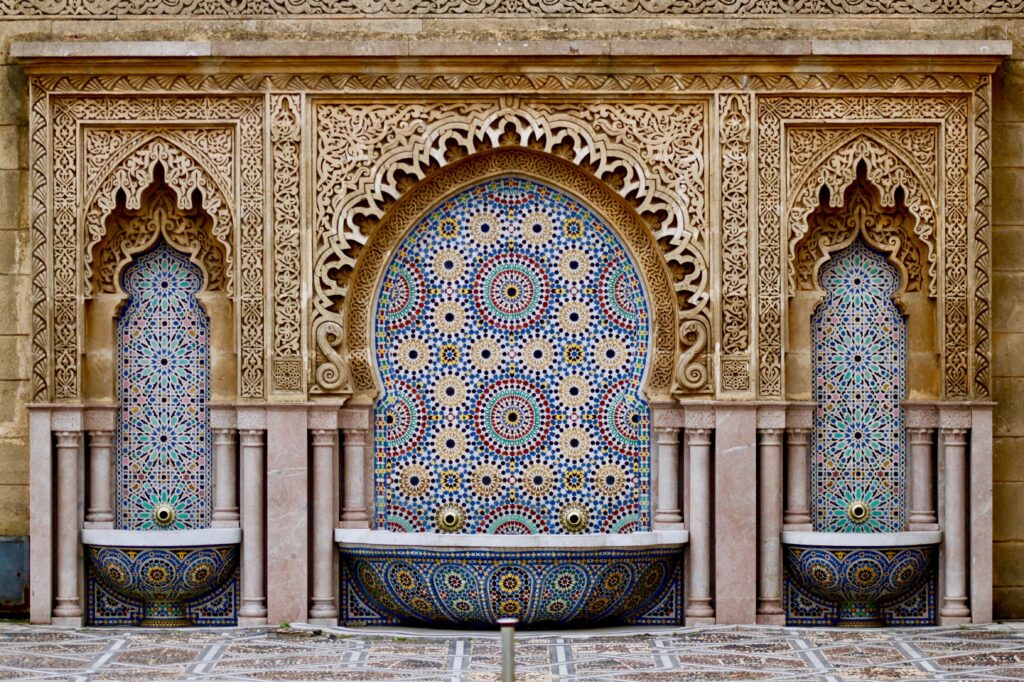
The medina of Rabat is not just a historical relic; it is a bustling marketplace where traditional crafts come to life. Skilled artisans, carrying the legacy of generations, create intricate ceramics, textiles, and metalwork. The medina is a living workshop, where the continuity of these crafts becomes an essential part of Rabat’s cultural narrative.
The National Museum of Jewelry and Traditional Arts further emphasizes the significance of these artisanal traditions. It showcases the exquisite craftsmanship that defines Moroccan jewelry, textiles, and other traditional art forms. Rabat’s commitment to preserving these crafts is not just about heritage; it is about sustaining livelihoods and fostering a cultural ecosystem that thrives on the mastery of skilled hands.
Community Engagement: Nurturing Cultural Roots
Rabat’s cultural vibrancy is not a distant spectacle; it is deeply embedded in the daily lives of its residents. Community engagement initiatives play a crucial role in nurturing cultural roots. Educational programs, workshops, and interactive events are organized to foster a sense of pride and ownership among the residents, ensuring that cultural heritage is not just preserved but actively celebrated.
UNESCO Recognition: A Global Affirmation
The UNESCO World Heritage status bestowed upon Rabat in 2012 is not limited to its architectural treasures; it is a holistic affirmation of the city’s cultural vibrancy. The inscription recognizes Rabat as a living heritage, where the past is not relegated to museums but is an integral part of the city’s contemporary identity.
A Living Heritage in Every Step
In conclusion, Rabat’s cultural vibrancy is not a static reflection of the past but a living, breathing heritage that permeates every aspect of the city. From the resonant sounds of traditional music to the vibrant colors of festivals, from the strokes of street art to the mastery of traditional crafts, Rabat’s cultural richness is an invitation to immerse oneself in a living heritage—one that evolves with time, yet remains deeply rooted in the essence of Morocco’s capital.
Looking Forward: A UNESCO-Recognized Future
Rabat, with its UNESCO World Heritage status as a “Modern Capital and Historic City: a Shared Heritage,” stands at a pivotal juncture in its journey—a city that embraces its past while steadfastly looking toward the future. This recognition isn’t just a laurel to rest upon; it’s a guiding compass that shapes Rabat’s trajectory as it aspires to be a model for sustainable development, cultural preservation, and global collaboration.
The Grand Theatre of Rabat: A Cultural Beacon
In the heart of the city, the Grand Theatre of Rabat emerges as a symbol of Rabat’s commitment to a vibrant cultural future. This state-of-the-art venue, currently under construction, is poised to be a hub for artistic performances, ranging from traditional music and dance to contemporary theater and global productions. It represents a bold step toward positioning Rabat not only as a historical gem but also as a modern cultural epicenter on the global stage.
The Grand Theatre reflects Rabat’s forward-looking approach, acknowledging that cultural vibrancy is not static. It evolves, adapts, and finds new expressions, mirroring the dynamism of the city itself.
Sustainable Urban Development: Balancing Progress and Heritage
As Rabat continues to grow and urbanize, the city is faced with the challenge of preserving its cultural heritage amidst the demands of progress. The delicate balance between modern urban development and heritage preservation is a key consideration. Sustainable architecture and eco-friendly initiatives are woven into the city’s development plans, ensuring that Rabat’s growth is harmonious with its historical identity.
Initiatives like the Green Belt Project, which aims to create a sustainable and ecologically balanced zone around the city, showcase Rabat’s commitment to an environmentally conscious future. As the city expands, it does so with a vision that prioritizes both progress and the safeguarding of its unique heritage.
Digital Heritage Preservation: Navigating the Technological Frontier
In an era defined by technological advancements, Rabat is leveraging digital tools to preserve and promote its cultural heritage. Digital mapping, virtual tours, and interactive exhibits are becoming integral components of heritage preservation initiatives. These innovations not only facilitate remote access to Rabat’s historical sites but also contribute to ongoing conservation efforts.
By harnessing the power of technology, Rabat is ensuring that its cultural heritage is not confined to physical spaces alone. It becomes a global heritage, accessible to audiences around the world, fostering a deeper appreciation for the city’s rich history.
Cultural Exchange Programs: Building Bridges Across Borders
Rabat’s UNESCO recognition positions it as a global cultural ambassador. The city actively engages in cultural exchange programs, forging connections with other UNESCO-recognized cities and participating in international collaborations. These initiatives facilitate the sharing of knowledge, expertise, and cultural practices, contributing to a global dialogue on heritage preservation and urban development.
The International Network of Historic Cities (INHC), of which Rabat is an active member, exemplifies the city’s commitment to building bridges across borders. Through this network, Rabat not only shares its experiences but also learns from the successes and challenges faced by other historic cities, creating a collective vision for a sustainable and culturally rich future.
Community Involvement: A Shared Responsibility
Rabat’s UNESCO-recognized future is not a path walked by city planners alone; it is a collective journey that involves the active participation of the community. Residents, local businesses, and cultural organizations play a pivotal role in shaping the city’s trajectory. Community engagement programs, educational initiatives, and public forums create spaces for dialogue, ensuring that the aspirations of the people are considered in the city’s development plans.
Preserving Intangible Heritage: Nurturing Traditions
Beyond the tangible monuments and structures, Rabat’s UNESCO-recognized future places emphasis on preserving intangible heritage. Traditional crafts, music, cuisine, and the unique cultural practices that define daily life are considered invaluable components of Rabat’s identity. Initiatives to safeguard and promote these intangible aspects ensure that the city’s heritage remains a vibrant and integral part of contemporary life.
A Dynamic Tapestry Unfolding
In conclusion, Rabat’s UNESCO-recognized future is a dynamic tapestry unfolding at the intersection of tradition and innovation. As the city looks forward, it does so with a profound understanding that cultural heritage is not a relic of the past but a living, breathing entity that shapes its identity. With the Grand Theatre as a beacon, sustainable urban development as a guiding principle, and digital innovations as tools for preservation, Rabat is poised for a future where its rich history continues to resonate, inspire, and evolve. The UNESCO recognition is not the culmination but the beginning of a chapter where Rabat, as a living heritage, continues to script its narrative for generations to come.

